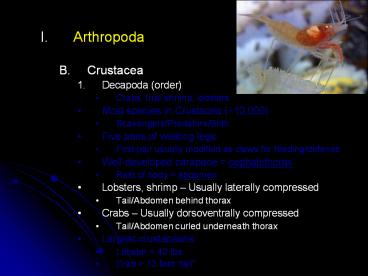Arthropoda - PowerPoint PPT Presentation
Title:
Arthropoda
Description:
Arthropoda Crustacea Decapoda (order) Crabs, true shrimp, lobsters Most species in Crustacea (~10,000) Scavengers/Predators/Both Five pairs of walking legs – PowerPoint PPT presentation
Number of Views:174
Avg rating:3.0/5.0
Title: Arthropoda
1
- Arthropoda
- Crustacea
- Decapoda (order)
- Crabs, true shrimp, lobsters
- Most species in Crustacea (10,000)
- Scavengers/Predators/Both
- Five pairs of walking legs
- First pair usually modified as claws for
feeding/defense - Well-developed carapace cephalothorax
- Rest of body abdomen
- Lobsters, shrimp Usually laterally compressed
- Tail/Abdomen behind thorax
- Crabs Usually dorsoventrally compressed
- Tail/Abdomen curled underneath thorax
- Largest crustaceans
- Lobster gt 42 lbs
- Crab gt 13 feet tall
2
(No Transcript)
3
Hermit crab
Decorator crab
4
- Arthropoda
- Crustacea
- Decapoda (order)
- Crabs, true shrimp, lobsters
- Most species in Crustacea (10,000)
- Scavengers/Predators/Both
- Five pairs of walking legs
- First pair usually modified as claws for
feeding/defense - Well-developed carapace cephalothorax
- Rest of body abdomen
- Lobsters, shrimp Usually laterally compressed
- Tail/Abdomen behind thorax
- Crabs Usually dorsoventrally compressed
- Tail/Abdomen curled underneath thorax
- Largest crustaceans
- Lobster gt 42 lbs
- Crab gt 13 feet tall
5
Fig. 9-35
6
(No Transcript)
7
(No Transcript)
8
- Arthropoda
- Crustacea
- Decapoda (order)
- Diverse nutritional modes predators (Ex
lobsters), deposit feeders (Ex fiddler crabs),
suspension feeders (Ex mole crabs) - Dioecious
- May exhibit courtship behavior, territoriality
- Males often transfer spermatophores to female
with modified copulatory pleopods - Fertilization usually internal
- Eggs usually brooded
- Larvae pelagic
- Nauplius shrimp, other crustaceans
- Zoea crabs
9
(No Transcript)
10
Nauplius
Zoea Fig. 9-36
Megalopa
11
- Arthropoda
- Crustacea
- Copepoda
- Extremely abundant and important plankton
- Among most abundant animals on earth
- Benthic forms also important
- Important primary consumers of phytoplankton
- Many exhibit DVM
- Some parasitic forms
12
Harpacticoid copepods
Parasitic copepods
13
(No Transcript)
14
Herbivorous vs. Predatory Copepod
15
- Arthropoda
- Crustacea
- Euphausiacea (krill)
- Laterally compressed
- Up to 10 cm long (usually smaller)
- Head and anterior segments fused to form distinct
carapace - Widespread distribution
- Important primary consumers and predators
- Important prey for larger consumers
- Keystone species in some ecosystems (Southern
Ocean) - Aggregate in schools
- May be immense (450 sq km x 200 m _at_ gt1000 m-3)
- May molt rapidly predator avoidance?
16
(No Transcript)
17
(No Transcript)
18
- Arthropoda
- Crustacea
- Amphipoda
- Laterally compressed
- Generally small (lt 2 cm), but larger in deep
ocean - Widespread distribution
- Generally free living
- Important scavengers
- Often highly mobile
- Some sedentary forms
- Diverse lifestyles
- Brood young
19
(No Transcript)
20
(No Transcript)
21
(No Transcript)
22
(No Transcript)
23
- Arthropoda
- Crustacea
- Isopoda
- Dorsoventrally compressed
- Generally small (lt 2 cm), but larger in deep
ocean - Related to terrestrial pill bugs
- Widespread distribution
- Generally free living
- Important scavengers
- Often highly mobile
- Some parasitic forms
- Brood young
24
(No Transcript)
25
(No Transcript)
26
- Arthropoda
- Crustacea
- Cirripedia (barnacles)
- Active suspension feeders (filter feeders)
- Use feathery cirripeds (modified swimming
appendages) - Sessile (attached to surfaces)
- Fouling organisms (boats, hard surfaces, whales)
- Resemble mollusks superficially
- Some parasitic forms
- Simultaneous hermaphrodites
- Internal fertilization (How??)
27
(No Transcript)
28
Stalked
Sessile
Fig. 9-41
29
(No Transcript)
30
- Arthropoda
- Crustacea
- Cirripedia (barnacles)
- Active suspension feeders (filter feeders)
- Use feathery cirripeds (modified swimming
appendages) - Sessile (attached to surfaces)
- Fouling organisms (boats, hard surfaces, whales)
- Resemble mollusks superficially
- Some parasitic forms
- Simultaneous hermaphrodites
- Internal fertilization (How??)
31
(No Transcript)
32
- Arthropoda
- Crustacea
- Stomatopoda (mantis shrimp)
- Specialized predators
- Modified second pair of thoracic appendages
- Smashers (eat mollusks, crabs) Video Video
- Spearers (eat shrimp, fishes)
- Sophisticated eyes
- Three lobes (midband for color vision)
- Up to 16 photoreceptor types (humans have four)
- Can see ultraviolet polarized light
- Reproduction
- Female lays egg mass
- Zoea larvae in plankton up to three months






























